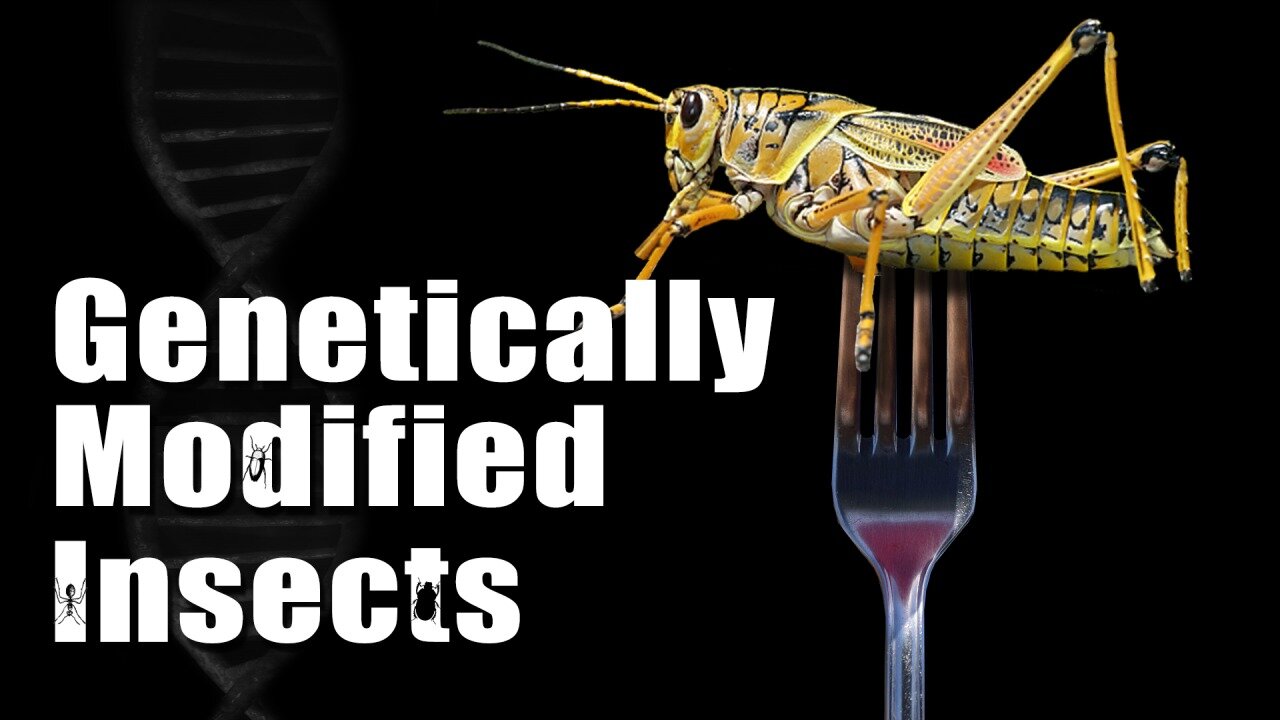Premium Only Content

Genetically Modified Insects – Risks Intentional?
Insects are really being made palatable to us in the media for some months now. Kla.TV raised attention to how this sudden medial change of mind came about, as well as to the risks and side effects existing with the consumption of insects already in the “Insects in food” file. But an even greater danger is lurking here.
Many people see biotechnology and genetic manipulation as the key to solving fundamental problems in food supply and healthcare. This is mainly because of today’s mainstream media coverage which promises us cheap food and new medicines. In the past, the reporting was much more balanced. In 1999, the German Bavarian Broadcasting Corporation ‘Bayrischer Rundfunk’ with its documentary “Bought Truth” still warned of the grave consequences following genetically modified food and the unscrupulous machinations of the biotech industry. Among other things, the scandalous dealings with Prof. Árpád Pusztai were published. With a feeding study that was independent from manufacturer’s interests, Pusztai showed that the consumption of genetically modified potatoes led to 36 significant changes in the rat’s organs after 10 days. Two days after this publication, he was fired and forced by contract not to contradict the biotech industry’s claims again in any form. This extreme influencing is possible because every scientist researching in this field is being paid directly or indirectly by the companies – with the consequence of practically nonexistent independent controls. Anyone who criticizes is muzzled.
In the 20 years since then, the power and possibilities of this network have even increased considerably. This was recently confirmed by the approval of further insects in food. The data required for this were not determined by the admission authority but were provided by the companies. In the end, all these regulations only serve to protect influential corporations and institutions from unwelcome competition. They prevent the uncovering of their machinations in order to keep the consumer in an artificial sense of security, so that they don’t become uncomfortable. In the following, we briefly explain how the existing possibilities of genetic engineering function and contrast the very positively portrayed chances with the dangers.
1. What is ‘Genetic engineering’?
For thousands of years, plants and animals were crossed according to the laws of heredity in order to enhance certain characteristics and reduce undesirable ones through this breeding selection. With this approach higher-yielding plant varieties or animals with more meat were bred naturally, for example. In genetic engineering, biotechnical processes are used to intervene in the genome (genome = genetic material) as well as the biochemical control processes of living organisms. This includes both the modification and recomposition of DNA sequences in the test tube as well as in living organisms. These biotechnically modified organisms do NOT occur naturally in nature.
2. Genetic engineering processes and products
The DNA (DNA = deoxyribonucleic acid = carrier of hereditary information) of a living organism is, so to speak, the building instruction that controls the development, function and reproduction of a living organism. Modifying parts of this blueprint also alters certain properties and characteristics of this living being. In the 1970s plants were first modified this way. In 1974, the first genetically modified mouse was born.
In 1994, the first genetically modified food, the Flavr-Savr tomato, came to the market. In this anti-mash tomato, genetic modification slowed the rotting process so that it looked fresh for 14 days longer. The most common grown genetically modified crops today are corn and soybeans that are resistant to certain manufacturers’ pesticides. Genetically modified microorganisms, such as transgenic yeasts and flavorings, have been found in processed foods for years. In medicine, hormones and some drugs are produced with genetically modified organisms.
Meanwhile, the issue has taken on a whole new dynamic. In the past, genetic engineering interventions were very expensive, complicated and time-consuming. This changed abruptly with the new technologies of genome editing, which is often also referred to as genome surgery. It involves the use of artificially produced enzymes that recognize the unwanted DNA sequence, cut it out and provide a new DNA sequence. This is then incorporated by the natural repair process in place of the original one. The most popular techniques for this are CRISPR (Clustered Regularly Interspaced Short Palindromic Repeats), Zinc-finger nucleases (ZFNs for short) and TALENs (Transcription Activator-like Effector Nucleases).
These techniques enable virtually any laboratory to perform genetic experiments within weeks for a few hundred dollars. The development is comparable to that of the first computer, which still filled an entire house, to today’s smartphone for everyone.
3. Risks and acceptance in the population
Due to possible health risks, many consumers reject genetically modified foods. The lack of well-founded scientific studies and the suppression of worrying reports – like for example the organ damage that was caused by genetically modified potatoes mentioned at the beginning of this broadcast confirm these concerns are more than justified. For many, also ethical reasons make it unacceptable that scientists play God and intervening in creation in this way. So at first the possibility to obtain new medications may sound positive, but this does not solve the original problem. For example, exploding cancer cases have been observed due to environmental pollution and our lifestyle habits. Remedial action would make much more sense than trying to conceal problems afterwards. Of course, the companies involved have no interest in this, since they are making top profits.
It becomes even more problematic, when gene drive technologies are used to turbo-charge proliferation. Instead of a gene being passed on to 50% of the offspring, as is normally the case, with gene drive it is 100%. This is already being used today, especially with yeasts and insects. With the effect that the natural species can be completely ousted by the species created through gene manipulation. This possibility of a genocide opens the door to power abuse – and this is no science fiction film scenario, it is already being practiced.
4. Circumventing research bans
If a scientist were to apply for funds to ensure that future generations of people could only have offspring if certain criteria were met, the media outcry would be great. But if this research is being hidden behind the seemingly noble goal of eradicating malaria, dengue or yellow fever, it is being funded many times over. For years, scientists have been experimenting on mosquitoes spreading these diseases. By genetically modifying these mosquitoes, future generations of female mosquitoes are supposed to become infertile and the disease to die out with them. However, this is not only being researched in the laboratory, it is practiced in field trials already. Similarly as with the Corona vaccination the scientists arouse the impression that both technology and their use are well controlled and side effect-free – however this is by far not the case! Instead, quite the opposite.
5. Pandora’s box is opened
The British biotechnology company Oxitec released more than 12 million genetically modified mosquitoes in Brazil from 2013 to 2015 in an attempt to contain the population of the yellow fever-carrying mosquito Aedes aegypti. According to the researchers, the released mosquitoes and their offspring should have died without continuing to reproduce with the wild form. Completely unexpectedly however, what the researchers said was impossible came true: 30 months later, up to 60% of the local mosquitoes were found to have the gene alteration. But not only that, the targeted and initially achieved 90% reduction in the mosquito population returned to its old level after 18 months. So the experiment not only failed to achieve its goal, but even spread the gene modification uncontrolledly. With unforeseeable consequences, such as the “new creatures” being even more resistant and dangerous. The consequences of such experiments have not been studied on the specious grounds that their technology is 100 percent lethal to female offspring. An assumption that has proved false – but nevertheless did not lead to a stop of these irresponsible experiments.
In addition to Brazil, genetically modified mosquitoes have also been released in Panama, Malaysia and the Cayman Islands, despite the alarming results. In the U.S. the gene mosquitoes have meanwhile been released in Florida and California, although the pathogens are not even present in California’s mosquito populations. In New York, the cabbage moths (Plutella xylostella), which have also been genetically modified by the biotech company Oxitec, have been tested in field trials, and the genetically modified red bollworm (Pectinophora gossypiella) in Arizona.
Genetic engineering? NO THANKS!
To date, there are no well-founded independent studies on the risks and long-term effects of genetically modified foods for the consumer. Nor have there been any studies on the effects of genetically modified plants and animals on flora and fauna. Some may argue that meanwhile this would have already been noticed. But many diseases are on the rise, such as allergies and cancer – who can safely rule out the possibility that this is not related to the genetically modified products? NOBODY!
That is exactly why genetically modified foods should be rejected for precautionary means. Just as one should reject research on plants and animals. Especially since it is schizophrenic when, according to the European Court of Justice, not even an abandoned field hamster burrow may be affected by a construction project, but at the same time millions of research funds are invested in a technology such as gene drive, which can lead to the genocide of an entire species the further consequences of which are unknown.
The insects currently advertised for consumption and the food synthetically produced from them alone harbor unimagined risks. It is unthinkable what following damage and costs we will be facing in 10 or 20 years’ time if insects will additionally be genetically modified. This is quite likely if we do not take decisive action. Influential institutions like Klaus Schwab’s World Economic Forum WEF and billionaires like Bill Gates promote both genetic engineering and the consumption of insects. Both are part of the implementation of their Transhumanism Agenda 2030.
In order to still be able to get GMO-free food tomorrow, each and every one of us is called upon. As consumers at the checkout and as critical citizens in discussions with political representatives. The more people who consistently say NO, the better our chances are. Therefore, please inform your friends and acquaintances about it.
THANK YOU!
from str
Sources/Links:
Intro
„Insects in Food“ File
www.kla.tv/25964
BR-documentary „Gekaufte Wahrheit“
https://www.bitchute.com/video/fhfWXbFwxjJT/
Prof. Árpád Pusztai
https://de.wikipedia.org/wiki/%C3%81rp%C3%A1d_Pusztai
What is ‘Genetic engineering’?
https://de.wikipedia.org/wiki/Gentechnik
Genetic engineering processes and products
https://www.youtube.com/watch?v=ZAz1GutJGbg&t=666s
https://www.spektrum.de/lexikon/ernaehrung/anti-matsch-tomate/571
https://de.wikipedia.org/wiki/Genome_Editing
Risks and acceptance in the population
https://de.wikipedia.org/wiki/Gene_Drive
Pandora’s Box is opened
https://www.dw.com/de/genver%C3%A4nderte-m%C3%BCcken-vermehren-sich-in-brasilien/a-50399709
https://www.testbiotech.org/aktuelles/freisetzung-gentechnik-muecken-florida
https://www.spektrum.de/news/gentechnisch-veraenderte-moskitos-in-florida-freigelassen/1870312
Genetic engineering? NO THANKS!
https://www.mdrjump.de/thema/feldhamster-bau-deutschland-schuetzen-aussterben-haustier-urteil-100.html
-
 LIVE
LIVE
JuicyJohns
21 minutes ago🟢#1 REBIRTH PLAYER 10.2+ KD🟢
52 watching -
 18:22
18:22
World2Briggs
20 hours ago $1.59 earnedThe New York Rant: Point Blank With No Fluff or BS. A Warning
11.7K7 -
 42:52
42:52
The Finance Hub
14 hours ago $1.49 earnedBREAKING: ALINA HABBA JUST SHOCKED THE WORLD!
10.5K23 -
 LIVE
LIVE
BEK TV
23 hours agoTrent Loos in the Morning - 8/26/2025
349 watching -
 12:15
12:15
Nikko Ortiz
18 hours agoMonday Gun Fails
69.7K15 -
 8:19
8:19
MattMorseTV
17 hours ago $10.85 earnedTrump is ACTUALLY DOING IT.
68.9K52 -
 5:40
5:40
Sugar Spun Run
1 day ago $0.78 earnedNutella Brownies
20.3K2 -
 8:46
8:46
Faith Frontline
16 hours agoBill Maher STUNNED as Charlie Kirk Proves God Exists
22K14 -
 LIVE
LIVE
FyrBorne
10 hours ago🔴Warzone M&K Sniping: On the Hunt For The Next Fun Builds
121 watching -
 7:11
7:11
MudandMunitions
13 hours agoNY Legal, Still LETHAL! Colt M4 + Griffin Armament GPS3X Prism Sight! NIGHT SHOOT
13.9K3